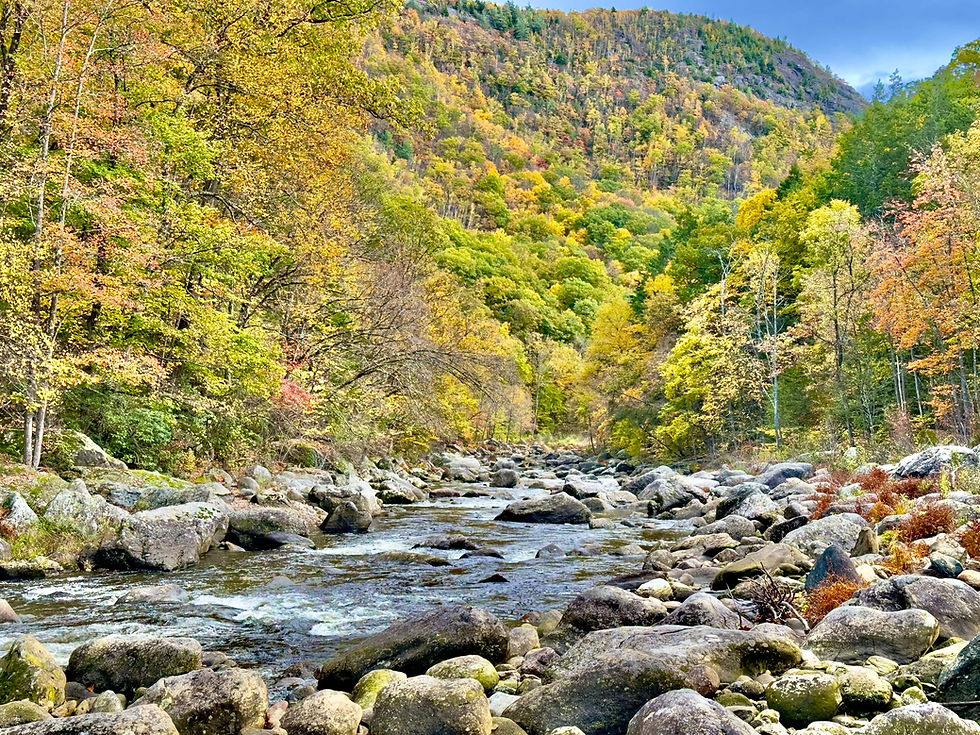Biostabilization Project to Address Erosion on Jacobs Brook in Orford, NH
- Diana Chaplin

- Oct 10
- 3 min read
Updated: Oct 30

[Press Release] The Connecticut River Conservancy's (CRC) work to reduce erosion and restore floodplains continues this fall with several implementation projects in New Hampshire thanks to funding from the USDA Natural Resources Conservation Service (NRCS) and the New Hampshire Charitable Foundation.
After several years of completing the necessary engineering design and permitting work, construction has begun for a biostabilization project on Jacobs Brook in Orford, NH. CRC hired a local engineer and contractor who specialize in this style of stream restoration work to design and implement the project. The effort will install large wood (the roots and bottom 20' of large trees) along the river’s edge and lower and terrace the riverbank behind the root wads. The root wads and terraces serve to slow the brook’s flow during storm events and give floodwaters more room to spread out.
A 50’ wide riparian buffer will be planted with native trees and shrubs after the root wads are secured and construction is completed. These roots help hold the soil in place and trap sediment, flood debris, and ice for years to come. The native vegetation will also help to cool river temperatures and provide riparian habitat.
During severe flooding in July 2017, many roadways and riverbanks along Jacobs Brook were damaged. Over the next several years, while roadway and bridge repair and improvement projects were completed, the destabilized streambanks have continually eroded. Property owner Shawn Washburn observed worsening impacts to the habitat in the stream with each passing storm as over 30 lateral feet of farmland were lost—land that had been in his family for seven generations. Without intervention, these streambanks would only continue to erode further.
Unsure of where to turn, Shawn reached out to NRCS for help, who connected him with the restoration team at CRC. CRC was able to help by applying for funds, obtaining the engineering design and permits, and coordinating the construction.
Lauren Zielinski, CRC's Stream Restoration Specialist, has been leading the project.
"CRC, NRCS, and the landowner have been in the planning phase of this project for the past two years and we are excited to finally break ground. This will have lasting benefits to the Jacobs Brook watershed and improve critical coldwater habitat in the region."
The goal of this project is to fix the severe erosion and use natural materials (rootwads and native vegetation) to dissipate the river’s energy, thereby reducing the potential for future erosion. An added benefit is that these natural materials also improve instream and riparian habitats. Once completed, this effort will have multiple benefits, including:
Lowering sediment and nitrogen inputs into Jacobs Brook, thereby improving water quality and brook trout habitat;
Increasing the amount of native vegetation on and around the streambank, providing long-term stabilization and increasing habitat for fish, birds, insects, and other wildlife; and
Preserving historic farmland in the Connecticut River Valley.
“I’ve been so impressed by the organization and professionalism of everyone involved. I’m very thankful that so many people came together on a project that will help the community, improve the habitat in the brook, and protect our 7th generation family farm here in Orford,” said Shawn Washburn. “Without CRC and NRCS, we wouldn’t be able to do this.”
This project was funded by the NRCS Regional Conservation Partnership Program and the New Hampshire Charitable Foundation’s Upper Connecticut River Mitigation and Enhancement Fund.

Left photo: A close up of a rootwads before being placed into the ground. A rootwad is a tree that has been removed from the ground with the roots still attached, limbs removed, and the trunk trimmed to 20-25 feet long.
Right photo: Rootwads after they have been installed along the streambank. This project will use about 20 rootwads to protect 170' feet of eroding bank.
This is just one of several that CRC and partners are implementing in New Hampshire, with additional projects recently completed or in the works in Walpole, Piermont, and Pittsburg. Over the years, CRC has implemented nearly two dozen of these large wood restoration projects throughout the Connecticut River watershed in NH, VT, MA, and CT.
Learn more about Connecticut River Conservancy's restoration projects here.
For questions about this announcement:
Lauren Zielinski
Stream Restoration Specialist
Connecticut River Conservancy
(603) 325-7022 | lzielinski@ctriver.org
Ron Rhodes
Director of Programs
Connecticut River Conservancy
(413) 768-4994 | Rrhodes@ctriver.org







